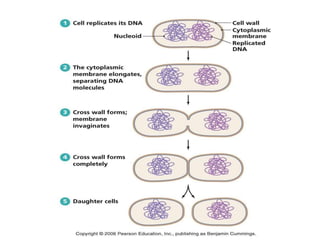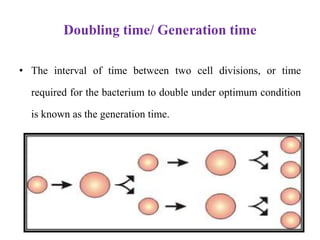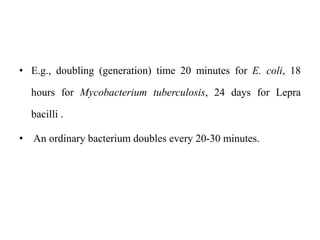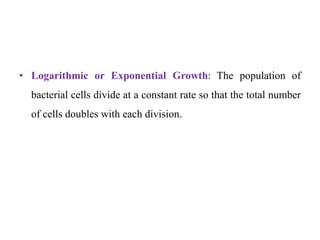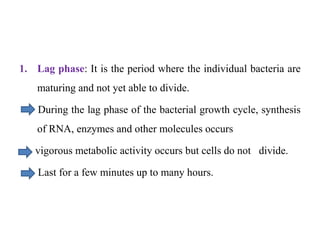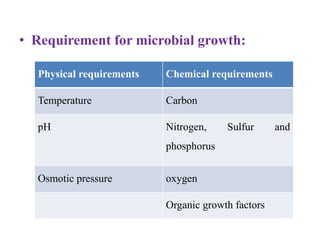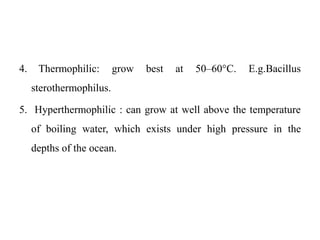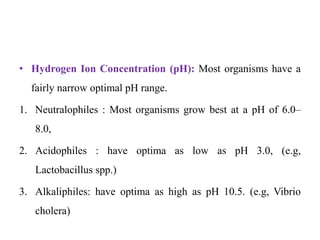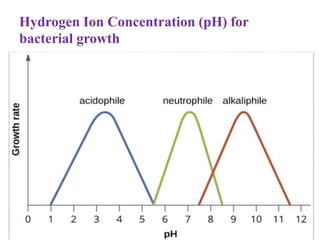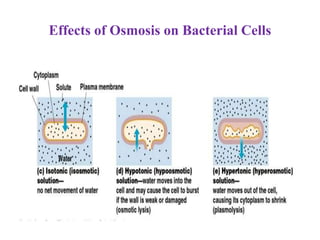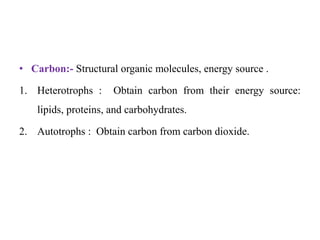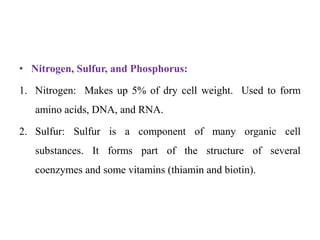Microbial Growth
- 1. WELCOME Dr. Hamima Hasnat Assistant Professor Department of Microbiology Eastern Medical College, Cumilla
- 3. Learning objectives : • What is binary fission? • What is doubling time or generation time? • In details about growth cycle of bacteria. • What are the components required for bacterial growth?
- 4. Binary fission • Bacteria divide by a Process called Binary Fission. • Binary Fission is a type of asexual reproduction in which a cell divides to produce two nearly equal-sized progeny cells.
- 5. Binary fision involves three processes: 1. Increase in cell size (cell elongation), 2. DNA replication and 3. Cell division
- 7. Doubling time/ Generation time • The interval of time between two cell divisions, or time required for the bacterium to double under optimum condition is known as the generation time.
- 8. • E.g., doubling (generation) time 20 minutes for E. coli, 18 hours for Mycobacterium tuberculosis, 24 days for Lepra bacilli . • An ordinary bacterium doubles every 20-30 minutes.
- 9. • Logarithmic or Exponential Growth: The population of bacterial cells divide at a constant rate so that the total number of cells doubles with each division.
- 11. • The growth cycle of bacteria has four major phases: lag, exponential (log), stationary, and death
- 12. 1. Lag phase: It is the period where the individual bacteria are maturing and not yet able to divide. During the lag phase of the bacterial growth cycle, synthesis of RNA, enzymes and other molecules occurs vigorous metabolic activity occurs but cells do not divide. Last for a few minutes up to many hours.
- 13. The length of lag phase depends upon : a. Type of bacteria. b. Better the medium, shorter the lag phase. c. The phase of culture from which inoculation is taken. d. Size or volume of inoculum. e. Environmental factors like temperature.
- 14. 2. The log (logarithmic) phase : In logarithmic phase the bacterial cell start dividing. rapid cell division occurs. their number increase by geometric progression with time Continue as long as cells have adequate nutrients & good environment Many antibiotics, such as penicillin, are most efficacious during this phase
- 15. 3. The stationary phase: Reproduction rate is balanced by the death rate and population remains constant. There is exhaustion of some nutrients and accumulation of some toxic materials In this stage microbial death is equal to microbial growth Metabolic activity of surviving cells slows down which stabilizes the population
- 16. The insufficient supply of nutrients also causes some bacteria to form spores during this phase. Cells frequently are gram variable and show irregular staining due to the presence of intracellular storage granules.
- 17. Why enter the stationary phase: • Nutrient limitation (slow growth) • Oxygen limitation • Accumulation of toxic waste products • Critical population density reached
- 18. 4. Death or Decline phase: It is final phase which is marked by a decline in the number of viable bacteria. death exceeds division. Sometimes a small numbers of survivors may persist for month even after death of majority of cells these few surviving cells probably grow at expence of nutrients released
- 19. The factors responsible are: a. Nutritional exhaustion b. Toxic accumulation c. Autolytic enzymes
- 20. • The growth curve: It indicates logarithm of the number of viable cells versus the incubation time.
- 22. • Requirement for microbial growth: Physical requirements Chemical requirements Temperature Carbon pH Nitrogen, Sulfur and phosphorus Osmotic pressure oxygen Organic growth factors
- 23. • Temperature: Different microbial species vary widely in their optimal temperature ranges for growth. 1. Psychrophilic: grow best at low temperatures (–5 to 15°C). e.g: Yersinia enterocolitica , Listeria monocytogens. 2. Psychrotrophs: have a temperature optimum between 20°C and 30°C but grow well at lower temperatures. 3. Mesophilic: grow best at 30–37°C, Most organisms are mesophilic. E.g. Escherichia coli , staphylococcus aureus , etc.
- 24. 4. Thermophilic: grow best at 50–60°C. E.g.Bacillus sterothermophilus. 5. Hyperthermophilic : can grow at well above the temperature of boiling water, which exists under high pressure in the depths of the ocean.
- 26. • Hydrogen Ion Concentration (pH): Most organisms have a fairly narrow optimal pH range. 1. Neutralophiles : Most organisms grow best at a pH of 6.0– 8.0, 2. Acidophiles : have optima as low as pH 3.0, (e.g, Lactobacillus spp.) 3. Alkaliphiles: have optima as high as pH 10.5. (e.g, Vibrio cholera)
- 27. Hydrogen Ion Concentration (pH) for bacterial growth
- 28. • Osmotic Pressure :Most bacteria require isotonic solutions. If the cells are placed in a high salt or sugar solution the cells lose water and plasmolysed. 1. Halophiles: Require moderate to large salt concentrations. E.g, Most bacteria in oceans. 2. Extreme or Obligate Halophiles: Require very high salt concentrations (20 to 30%). E.g, Halobacterium.
- 29. 3. Facultative Halophiles: Do not require high salt concentrations for growth, but tolerate 2% salt or more. E.g, Vibrio parahaemolyticus.
- 30. Isotonic Versus Hypertonic Solution Plasmolysis
- 31. Effects of Osmosis on Bacterial Cells
- 32. • Carbon:- Structural organic molecules, energy source . 1. Heterotrophs : Obtain carbon from their energy source: lipids, proteins, and carbohydrates. 2. Autotrophs : Obtain carbon from carbon dioxide.
- 33. • Nitrogen, Sulfur, and Phosphorus: 1. Nitrogen: Makes up 5% of dry cell weight. Used to form amino acids, DNA, and RNA. 2. Sulfur: Sulfur is a component of many organic cell substances. It forms part of the structure of several coenzymes and some vitamins (thiamin and biotin).
- 34. 3. Phosphorus: Used to form DNA, RNA, ATP, and phospholipids, coenzymes like NAD, NADP, and flavins. In addition, many metabolites, lipids (phospholipids, lipid A), cell wall components (teichoic acid), some capsular polysaccharides, and some proteins are phosphorylated.
- 35. • Oxygen : 1. Obligate aerobes: Require oxygen to live. Example: Pseudomonas spp. 2. Facultative anaerobes: able to live aerobically or anaerobically; Examples: E. coli, Staphylococcus. 3. Obligate anaerobes : Cannot use oxygen and are harmed by the presence of toxic forms of oxygen. Examples: Clostridium bacteria that cause tetanus and botulism.
- 36. 4. Microaerophiles: which require small amounts of oxygen (2– 10%) for aerobic respiration (higher concentrations are inhibitory). Example: Campylobacter. 5. Aerotolerant anaerobes: Can’t use oxygen, but tolerate its presence. Can break down toxic forms of oxygen. Example: Lactobacillus carries out fermentation regardless of oxygen presence.
- 37. • Toxic Forms of Oxygen: 1. Superoxide Free Radicals (O2-.): Extremely toxic and reactive form of oxygen. All organisms growing in atmospheric oxygen must produce an enzyme superoxide dismutase (SOD), to get rid of them. SOD is made by aerobes, facultative anaerobes, and aerotolerant anaerobes, but not by anaerobes or microaerophiles. Reaction: O2-. + O2-. + 2H+ ----------------> H2O2 + O2 SOD Superoxide free radicals Hydrogn peroxide
- 38. 2. Hydrogen Peroxide (H2O2): Peroxide ion is toxic .There are two different enzymes that break down hydrogen peroxide: A. Catalase: Breaks hydrogen peroxide into water and O2. 2H2O2----------> 2H2O + O2 Gas Bubbles Hydrogen peroxide catalase
- 39. • B. Peroxidase: Converts hydrogen peroxide into water. H2O2 + 2H+---------------> H2O • All strict anaerobes lack both superoxide dismutase and catalase. Hydrogen peroxide Peroxidase
- 40. Other Elements: • Potassium, magnesium, and calcium are often required as enzyme cofactors. • Calcium is required for cell wall synthesis in Gram positive bacteria. Trace Elements: • Many are used as enzyme cofactors. Commonly found in tap water. • Iron, Copper, Molybdenum Zinc.
- 41. Organic growth factors: • Organic compounds are required by bacteria for their growth and maintenance. • Such as vitamins, amino acids, purines, and pyrimidines. • A growth factor may be essential for some bacteria and accessory for other bacteria, and totally unrequired by some others. • E.g. H.influenza requires accessory growth factors X & V.
- 43. Thank you





